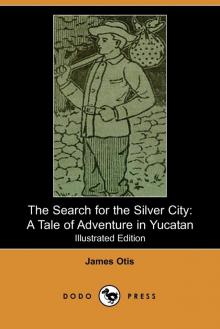


The Search for the Silver City: A Tale of Adventure in Yucatan
James Otis

Produced by Jana Srna, Suzanne Shell and the OnlineDistributed Proofreading Team at https://www.pgdp.net
Instead of releasing his hold on Neal the reptileheld firm, etc. See Page 193.]
THE SEARCH FOR THE SILVER CITY.
A TALE OF ADVENTURE IN YUCATAN.
By JAMES OTIS.Author of "The Castaways," "A Runaway Brig," "TheTreasure Finders," etc., etc.
ILLUSTRATED.
NEW YORK:A. L. BURT, PUBLISHER.
Copyright, 1893, by A. L. BURT.
INTRODUCTION.
In Mr. E. G. Squier's preface to the translation of the Chevalier ArthurMorelet's "Travels in Central America" the following paragraph can befound:
"Whoever glances at the map of Central America will observe a vastregion, lying between Chiapas, Tabasco, Yucatan, and the republic ofGuatemala, and comprising a considerable part of each of those states,which, if not entirely a blank, is only conjecturally filled up withmountains, lakes and rivers. It is almost as unknown as the interior ofAfrica itself. We only know that it is traversed by nameless ranges ofmountains, among which the great river Usumasinta gathers its watersfrom a thousand tributaries, before pouring them, in a mighty flood,into the Lagoon of Terminos, and the Gulf of Mexico. We know that it hasvast plains alternating with forests and savannas; deep valleys wheretropical nature takes her most luxuriant forms, and high plateaus darkwith pines, or covered with the delicate tracery of arborescent ferns.We know that it conceals broad and beautiful lakes, peopled with fishesof new varieties, and studded with islands which supports the crumblingyet still imposing remains of aboriginal architecture and superstition.And we know, also, that the remnants of the ancient Itzaes, Lacandones,Choles, and Manches, those indomitable Indian families who successfullyresisted the force of the Spanish arms, still find a shelter in itsfastnesses, where they maintain their independence, and preserve andpractice the rites and habits of their ancestors as they existed beforethe discovery. Within its depths, far off on some unknown tributary ofthe Usumasinta, the popular tradition of Guatemala and Chiapas placesthat great aboriginal city, with its white walls shining like silver inthe sun, which the _cure_ of Quiche affirmed to Mr. Stephens he had seen,with his own eyes, from the tops of the mountains of Quesaltenango."
In Stephens' "Yucatan," Vol II, page 195, are the following lines:
"He (meaning the padre of Quiche, with whom Mr. Stephens wasconversing), was then young, and with much labor climbed to the nakedsummit of the Sierra, from which, at a height of ten or twelve thousandfeet, he looked over an immense plain--and saw at a great distance alarge city spread over a great space, and with turrets white andglittering in the sun. The traditionary account of the Indians of Chajulis, that no white man has ever reached this city, that the inhabitantsspeak the Maya language, are aware that a race of strangers hasconquered the whole country around, and murder any white man whoattempts to enter their territory. They have no coin or othercirculating medium; no horses, cattle, mules, or other domestic animalsexcept fowls, and the cocks they keep under ground to prevent theircrowing being heard. One look at that city would be worth ten years ofan every-day life. If he (the padre) is right, a place is left whereIndians and an Indian city exist as Cortez and Alvarado found them;there are living men who can solve the mystery that hangs over theruined cities of America; who perhaps can go to Copan and read theinscriptions on its monuments. No subject more exciting and attractivepresents itself to my mind, and the deep impression will never beeffaced."














